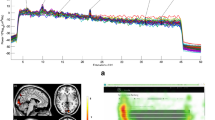Abstract
A new noninvasive device for measuring pulsatile blood flow is described. This device operates on the same well known principle as the invasive electromagnetic flowmeter. The theoretical aspects are developed from Maxwell's equations to obtain the direct relationship between blood flow rate and measured electrical potentials, which allow calibration in this method. Computerised signal processing is used to purify these potentials from noise and to isolate the pulsatile blood flow signal from physiological artefacts such as the electrocardiogram and ballistocardiogram.In vivo andin vitro experiments have been performed to determine the influences of physical and biological factors on the recorded blood flow curve. Correlation with the invasive electromagnetic device has been established. Application to the measurement of the pulsatile blood flow from human lower limbs is presented.
Similar content being viewed by others
References
Boccalon, H., Berryer, P., Malm, J. R., Doll, H. G. andNahas, G. G. (1973) Post prandial increases of limb blood flow in normal man.Fed. Proc., Circulation, Abstr. Fedn. Am. Soc. Exper. Biol., (Peripheral Circulation), 3:1141.
Boccalon, H., Nahas, G.G., McAllister, F., Voorhees, A., Buda, J. andDoll, H.G. (1974) Surface electromagnetic rheography in patients with peripheral artery disease.Circulation,49, 50.
Boccalon, H., Berryer, P., Doll, H.G., McAllister, F. andNahas, G. G. (1975) Noninvasive electromagnetic flowgraphy as an index of arterial blood flow in man. Bulletin of the New York Academy of Medicine, 51/2, 310.
Boccalon, H., Candelon, B., Puel, P., Enjalbert, A. andDoll, H. G. (1977) Assessment of pulsatile blood flow by a noninvasive electromagnetic device. InNoninvasive cardiovascular diagnosis-current concepts,Dietrich,E. B. (Ed.), University Park Press, Baltimore, 231–240.
Boccalon, H., Candelon, B., Doll, H. G., Puel, P. andEnjalbert, A. (1978) Noninvasive electromagnetic measurement of the peripheral pulsatile blood flow: experimental study and clinical application.Cardiovascular Research,12, 66–68.
Boccalon, H., Candelon, B., Doll, H. G., Puel, P. F. andEnjalbert, A.P. (1979) Myocardial contractility: noninvasive assessment after cardiac surgery.Resuscitation,7, 163–168 numbers 3 and 4.
Boccalon, H., Candelon, B., LeBlanc, A., Puel, P., Enjalbert, A. andDoll, H. G. (1979) Computer monitoring of cardiac performance from patients recovering from cardiac surgery. InAcute Care,Tavares, B. M. andFrey, R. (Eds.), Springer-Verlag, 282–286.
Boccalon, H., Puel, P. F., Candelon, B. andEnjalbert, A. P. (1979) Noninvasive electromagnetic blood flow measurement: a study of 500 arteriosclerotic patients. InHemodynamics of the limbs 1,Puel, P., Boccalon, H. andEnjalbert, A. (Eds.) 197–208.
Boccalon, H., Puel, P., Candelon, B. andEnjalbert, A. (1979) Lower extremity hemodynamics: noninvasive blood flow recordings, Doppler signal analyses, post exercise ankle pressure. Proceedings symposium on noninvasive diagnostic techniques in vascular disease, San Diego, 88.
Boccalon, H., Puel, P., Doll, H. G. Candelon, B. andEnjalbert, A. (1981) Noninvasive assessment of myocardial performance by electromagnetic blood flow measurement at the ascending aorta level. InNoninvasive cardiovascular diagnosis,Dietrich,E. B. (Ed.), P.S.G. Publishing Co., Littleton, 423–431.
Boccalon, H., Lozes, A., Chikhany, G., Puel, P. andEnjalbert, A. (1981) Noninvasive electromagnetic blood flow measurement: relationship between pulsatile flow and pressure. InHemodynamics of the Limbs II,Puel, P., Boccalon, H. andEnjalbert, A. (Eds.) Toulouse, 177–185.
Cappelen, C. andHall, K. V. (1967) Electromagnetic flowmetry in clinical surgery.Acta. Chir. Scand. Suppl.,356B, 129–133.
Faraday, M. (1832) Experimental research in electricity, terrestrial magneto-electric induction, 2nd Series.Phil. Trans.,122, 163–177.
Franklin, D. L., Schelel, W. andRushmer, R. F. (1961) Blood flow measured by Doppler frequency shift of backscattered ultrasound.Sciences,134, 564–565.
Gams, E., Huntsman, L. andChimoskey, J. (1974) Correlation of maximum aortic and carotid flow acceleration in chronically instrumented dogs.Circulation Res.,34, 302–308.
Gessner, U. andBergel, D. H. (1964) Frequency response of electromagnetic flowmeters.J. Appl. Physiol.,19 1209.
Giron, F., Birtwell, W. C., Soroff, H. S. andDeterling, R. S. (1966) Hemodynamic effects of pulsatile and nonpulsatile flow.Arch. Surgery,93, 802–810.
Kolin, A. (1936) An electromagnetic flowmeter; principle of method and its application to blood flow measurements.Proc. Soc. Exp. Biol.,35, 53.
Lee, B. Y., Trainor, F. andMadden, J. L. (1971) Significance of arterial blood flow in reconstructive arterial procedure.Surgery, Gynecology, Obstetrics,5, 803–816.
Lee, B. Y., Trainor, F. andKavner, D. (1975) A clinical evaluation of a noninvasive electromagnetic flowmeter.Angiology,26, 317–328.
MacDonald, D. A. (1960)Blood flow through arteries. William & Wilkins Co., Baltimore.
Mandelbaum, L. andBurns, W. M. (1975) Pulsatile and non-pulsatile blood flow.J. Am. Medical Assoc.,191, 657–660.
Many, M., Soroff, H. S., Birwell, W. C., Giron, F., Wise, H. andDeterling, R. A. (1967) The physiologic role of pulsatile and non-pulsatile blood flow.Arch. Surgery,95, 762–767.
Nyboer, J. (1971)Electrical impedance plethysmography, 2nd Ed.Thomas, C. C., (Ed.)
Okai, O., Togawa, T. andOshima, M. (1971) Magnetorheography: non-bleeding measurement of blood flow.J. Appl. Physiol.,30, 564–566.
Roberts, V. C. (1973) Measurement of flow in intact blood vessels.CRC. Crit. Rev. Bioeng.,1, 419.
Rushmer, R. F. (1964) Initial ventricular impulse: a potential key to cardiac evaluation.Circulation,29, 268–283.
Salles-Cunha, S. X., Battocletti, J. H. andSances, A., Jr. (1980) Noninvasive electromagnetic blood flowmetry: multivessel models for quantitation and analysis of flow induced signals. InFrontiers of Engineering in Health Care, IEE, 350–355.
Shercliffe, J.A. (1962)The theory of electromagnetic flowmeters. IRE, Cambridge University Press.
Terry, H. J. (1980) The electromagnetic flowmeter. InMethods in angiology,Verstraete, M. (Ed.) The Hague, 21–36.
Wetterer, E. (1937) A new method of measuring blood flow in unopened vessels.Z. Biol.,98, 26.
Wilkens, H., Regelson, H. andHoffmeister, F. S. (1962) The physiologic importance of pulsatile blood flow.Br. J. Medicine,267, 443–446.
Author information
Authors and Affiliations
Rights and permissions
About this article
Cite this article
Boccalon, H., Lozes, A., Newman, W. et al. Noninvasive electromagnetic blood flowmeter: Theoretical aspects and technical evaluation. Med. Biol. Eng. Comput. 20, 671–680 (1982). https://doi.org/10.1007/BF02442519
Received:
Issue Date:
DOI: https://doi.org/10.1007/BF02442519




